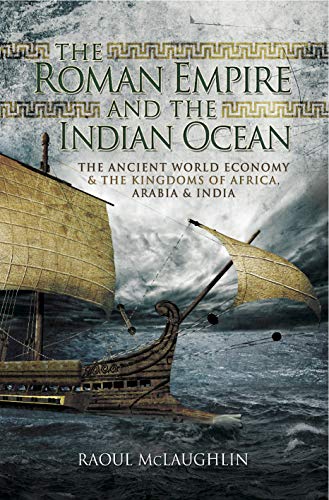The Roman Empire and the Indian Ocean: The Ancient World Economy & the Kingdoms of Africa, Arabia & India Kindle Edition
By McLaughlin Raoul
Published on 19 Oct 2022
Review:
The Roman Empire and the Indian Ocean - Rome's Dealings with the Ancient Kingdoms of India, Africa and Arabia
by McLaughlin Raoul
- Publisher: Pen & Sword Maritime; Reprint edition (21 May 2018)
- Language: English
- Paperback: 304 pages
- ISBN-10: 1526738074
The book deals with questions like: how did the Roman Empire function, and, in particular, how did it pay for its military costs? The author believes that answers to questions such as these require a wider view than that reflected in most classical historians, who focus almost entirely on the Mediterranean and Western Europe. They have tended to ignore Roman contacts with eastern civilizations.
But, writes McLaughlin, the Roman Empire ‘belonged to an ancient world economy that stretched thousands of miles across the Indian Ocean and significant commercial contacts linked Roman subjects with their distant counterparts in east Africa, southern Arabia and the kingdoms of ancient India’. He adds that these trade exchanges are confirmed by testimony from different cultures and by many archaeological finds.
McLaughlin argues that the Romans were pretty much aware that their Mediterranean empire was not the only powerful regime in the world at the time, and there were major powers in the East that matched Roman administration.
According to McLaughlin, while some Latin poets aired ideas of a global Roman authority, their views were far from reality. He writes that anyone in a Roman crowd moving through a commercial district ‘could see evidence of a wider ancient world in the fashions worn by rich patrons, the incense burnt at religious altars, or the spices that flavored many Mediterranean meals’.
The book goes on to explain how these distant contacts with Asia provided Rome with the revenues it needed to finance its army and sustain its empire.
McLaughlin writes that while the Romans knew about India, they were unaware of the Far East until the first century BC. That was when Chinese silk began to cross thousands of miles of steppe and reach the Mediterranean region via the Parthian Empire, which ruled ancient Iran.
The book, which covers the economy of ancient Rome, covers a great deal of ground discussing trade relations with Petra and the Nabataeans, Egypt, and the Egyptian-African kingdom of Meroe in present-day Sudan. He discusses East Africa and the Aksumite kingdom, Saba-Himyarites, and the Hadramawt Kingdom.
The book also covers the Red Sea Route, and the scale and significance of the Indian Ocean trade. From there the author discusses the Indo-Parthians, the Saka and Satavahana kingdoms, the Tamil kingdoms of southern India, the Anuradhapura kingdom of Sri Lanka, and the Far East, including the Antun Embassy to China.
There is a great amount of discussion of the various commodities trades, from black pepper and pearls.
McLaughlin argues that the Romans were pretty much aware that their Mediterranean empire was not the only powerful regime in the world at the time, and there were major powers in the East that matched Roman administration.
According to McLaughlin, while some Latin poets aired ideas of a global Roman authority, their views were far from reality. He writes that anyone in a Roman crowd moving through a commercial district ‘could see evidence of a wider ancient world in the fashions worn by rich patrons, the incense burnt at religious altars, or the spices that flavored many Mediterranean meals’.
The book goes on to explain how these distant contacts with Asia provided Rome with the revenues it needed to finance its army and sustain its empire.
McLaughlin writes that while the Romans knew about India, they were unaware of the Far East until the first century BC. That was when Chinese silk began to cross thousands of miles of steppe and reach the Mediterranean region via the Parthian Empire, which ruled ancient Iran.
The Parthians understood the profits to be made by controlling overland trade and therefore denied Roman subjects access to the caravan routes that led across Iran.
The world changed in 30 BC, when Rome annexed Egypt and gained access to the Red Sea shipping lanes leading to the Indian Ocean. By the year 20 BC, there were over a hundred Roman ships sailing to India. Mediterranean markets began to be flooded by Asian goods. These included spices, incense, gemstones and silks. The taxes on these imports yielded enormous new revenues for the imperial regime in Rome – as much as a third of the income it required to finance the entire empire, according to the author.
Emperor Augustus used the new revenues to raise a full-time professional army, which grew to a strength of 300,000 professional soldiers. This army was used to defend the Roman Empire’s distant frontiers and to maintain order in subject nations.
Did you know about ‘Buddhist Romans’? Well, if you did not, you will find some discussion here of Buddhist Romans. The book describes how Roman merchants visiting the Satavahana city-port of Kalliena (Kalyan, near Mumbai) sold stuff like Italian wine, lead ingots and antique bronze objects, mirrors, and tableware.
According to McLaughlin, the carved Prakrit inscriptions in the ancient Buddhist cave monasteries of the Western Deccan record how Yavanas (Greeks and Romans) were active in the region. He refers to the mention of Yavanas in inscriptions in ancient monasteries at Nasik, Junnar and Karle in present-day Maharashtra state in India.
The book is full of historical detail about the regions of the world with which ancient Rome traded. He describes the Roman ships in some detail as he does the spices and wine trade. He also discusses the trade in incense from Arabs and ivory and animal hides from north-east Africa.
All in all, a very interesting book that on how Europeans traded with Asia and Africa in ancient times.










